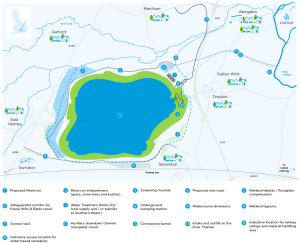East Hendred Parish Council, in line with Oxfordshire County Council and the Vale of the White Horse District Council, is opposed to the proposed development of a 100M litre reservoir near Steventon, in an adjacent parish. This scheme, alternatively known as SESRO (South East Strategic Reservoir Option), would be built in the Upper Thames catchment, to the South West of Abingdon in Oxfordshire. It would be filled with water from the River Thames during periods of high river flow. When river levels drop or demand for water increases, water would be released back into the River Thames for re-abstraction downstream.
The scheme has been designed to provide additional water to Affinity Water, Southern Water and to the London area (rather than for local use).

East Hendred Parish Council opposition centres on:
- The need for a public inquiry to test the assumptions implicit in the analysis of demand and address the options independently
- The requirement for a stronger focus on leakage reduction as a priority, targeting reduction levels of at least 80% from current levels (removing the need for new infrastructure/schemes altogether)
- An independent verification of population and housing growth assumptions – using ONS data preferentially as the basis of demand forecasting
- A strong preference for a national water transfer infrastructure to move water from high rainfall areas (Northern England, Wales) to low areas (eg SE, East Anglia), with any new infrastructure preferentially moving us towards this strategy eg early implementation of the Severn-Thames Transfer scheme or Grand Union Canal scheme, rather than new-build mega-reservoir construction in Steventon (Abingdon)
- The need for :
- A fully costed solution to be created (the current design is illustrative and has not been fully costed)
- A full, independent safety assessment to be undertaken
- A full, independent environmental impact assessment to be undertaken (to include biodiversity loss assessment, construction carbon footprint etc)
- An assessment of local community impact to be undertaken
- All of the above have been made available for extensive independent and public scrutiny
- Other solutions, close to the demand need (eg desalination in Kent, Sussex, East Anglia, London) to be brought to the table for comparative, independent analysis
- The stakeholder group to be expanded beyond the water companies themselves, to assess plans independently and drive better strategic thinking
- Ofwat to review the water company reward mechanisms to ensure that water company decision-making is not driven by stakeholder value, but by strategic need and appropriateness and viability of the solution
- The requirement for Ofwat and the relevant Governmental department to hold Thames Water directly to account over:
- Its high leakage rate (>50% greater than the national average at >150 litres per household property per day)
- Its repeated failure to meet its leakage reduction targets
- Its terrible performance on sewage discharge into rivers at times of high rainfall/flood (remembering, of course, that Thames will fill the proposed reservoir at these times)
- Its sale of 26 reservoirs to date (wholly inconsistent with a new reservoir build strategy)
If you would like to get involved or need more information, please go to the GARD (Group Against Reservoir Development) website www.gard-oxon.org.uk
The WRSE (Water Resources South East) website contains more information https://www.wrse.org.uk/